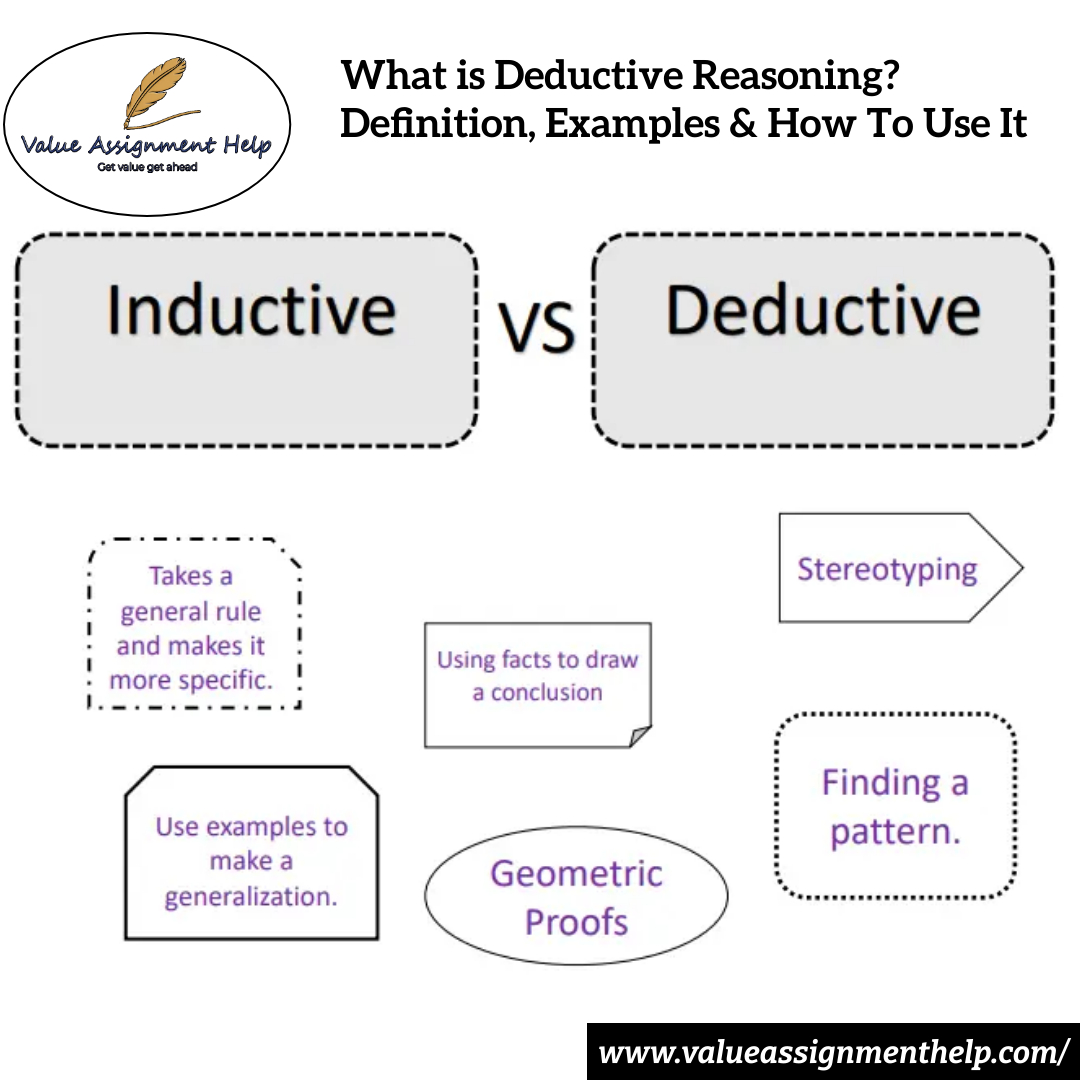
Search Assignments
Table of Contents
Our Experts

Search Assignments

Customers Reviews
Definition, Examples & How to Use It
There is nothing better than deductive reasoning to win an argument or test. But, such logical reasoning leads to conclusions void of certainty. Deductive arguments have to satisfy strict conditions like content specifications for logical observations. Therefore, knowing the pitfalls of deductive reasoning and recognising an invalid deduction form is an excellent way to sharpen your critical thinking skills.

Deductive reasoning is the process of concluding based on premises, generally believed to be accurate. Also called deductive reasoning, this act uses a logical premise to arrive at logical conclusions. Deductive reasoning is often referred to as top-down reasoning. If one thing is accurate and another is related to the first assumption, then the fundamental truth must also be actual for the second.
For example, if the trunk of the car is large and the bike does not fit in the trunk, you may assume that the bike must be more prominent as well. We know this because we were already provided with the information we believe to be true that the trunk is extensive. As a result of our deductive reasoning abilities, we know that a bike must be enormous if it doesn't already fit into a large trunk. As long as the two premises are based on accurate information, the result of this type of inference is often actual.
With deductive reasoning, premises are used to conclude. For example, a marketing manager may realise that his department is spending more than the budget on advertising. After reviewing the numbers, they see that while the company's Facebook ads get a lot of clicks, the number of contacts through their email list is high.
The manager decides to reduce Facebook advertising to stay within budget and focus on getting consumers to sign up for their email list. As a result, the department remains under budget in the next quarter, and sales remain stable.
The manager followed the deductive reasoning process. Here's how deductive reasoning typically works in the workplace:
Deductive and inductive reasoning are not the only types of reasoning. You may also come across abductive reasoning, backward induction and critical thinking. Let's see what these types of reasonings are:
The different types of deductive reasoning are based on the premises and the type of relationship in the premises. The three types of deductive reasoning are syllogism, modus ponens, and modus tollens. Let us examine each deductive reasoning method in detail.
A Syllogism is a general form of deductive reasoning that consists of a set of premises followed by a concluding statement. The first premise is a conditional statement, and the second premise is another conditional statement that connects to the conclusion of the first premise. And the summary statement ends by connecting the first part of the first premise with the second part of the second premise.
This type of deductive reasoning may also be referred to as a confirmation of antecedents because the first statement is usually conditional. And the second statement only confirms the first part of the previous statement. Let us look at the example below to understand this concept of modus ponens.
In the workplace, deductive reasoning is a powerful tool. It is finding one or more premises to establish a logical conclusion.
Making decisions, solving problems, and analysing data can all be accomplished using deductive reasoning.
Many people know little about deductive reasoning, using facts to reach logical conclusions. However, deductive reasoning can be used in many different situations and is often called the opposite of inductive reasoning. Deductive reasoning can be used in many professional settings, but here we'll look at how it can be used within the workplace.
It is valuable to be able to use deductive reasoning in the workplace.
The deductive reasoning process involves using information generally believed to be accurate to conclude. The information you use is based solely on facts and is devoid of feelings, emotions, and other non-verifiable information.
By understanding how the deductive reasoning process works, you may be able to successfully apply it to solve problems you encounter in your workplace.
Make initial assumptions. You start by making an initial assumption generally believed to be accurate.
Build a second base. Then you consider a second premise which is related to this. So, if the initial assumption is correct, it is the second premise.
Conduct the test. You can test the assumption in different scenarios and note the results.
Conclude. Depending on the results you get, you can judge whether the information is valid or invalid.
Deductive reasoning is an essential skill in many different jobs and industries. For example, it is beneficial for people in management who have to make essential business decisions daily.
If you are looking for a new position, highlighting your deductive logic can show employers how you use logic to benefit the organisation.
To prepare, think about ways you've used deductive reasoning in the workplace. Consider these examples:
Inductive reasoning is another type of reasoning used at work. This form of reasoning is the opposite of deductive reasoning and occurs when broad generalisations are made based on specific events or facts. The following is an example of inductive reasoning: A lawyer analyses the various strategies used by other lawyers in cases similar to the lawyer's current case. As a result, the lawyer uncovers a consistent strategy used by other lawyers that have resulted in repeated acquittals and use this approach in his case.
Inductive reasoning is equally vital in the workplace and helps professionals use specific inferences to come to broader conclusions and solve problems.




No Comments